
Booze, Sailors & Health Menu: 1 2 3 4 5 6 7 8 9 10 11 12 13 14 15 16 17 18 19 Next>>
Booze, Sailors, Pirates and Health In the Golden Age of Piracy, Page 6
Alcohol: Wine
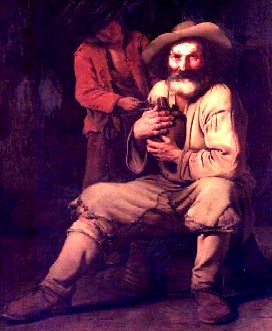
Artist: Michiel Sweerts -
The Drinker (1646-64)
Wine had a definite place among the alcohols consumed by the sailors during the golden age of pirates. It is the most often used alcohol in the sailor's accounts under study during the golden age of piracy being mentioned a total of one hundred eighteen times, including seventeen times in a navy sailor context1, fourty-four times in a navy officer context2, eighteen times in a merchant and privateer ship context3 and forty-four times in a pirate context.4 Most of the navy wines come from Chaplain Henry Teonge's account of the officers on the navy ships - he mentions fifty-eight types and instances of wine. They seem to have lived a merry life, drinking wine in his first voyage almost nightly according to his diary.
These numbers exclude mentions of palm wines (arrack), the watered down beverage wine the navy supplied to the before-mast men while they were at sea as well as the wine used in punch; each of these are discussed in their own section. It also excludes ten citations that mention the pirates taking wine aboard cargo, but don't actually say the pirates drank that wine; that information is only in a discussion on bottled wines versus casked wines. However, it is very likely that some of this wine was drunk by the pirates, so these numbers are probably a little conservative.
Several factors impacted the types of wines to which sailors had access at sea. Technical aspects were one of these factors. Many of the wines carried by merchant ships were the heavier, sweeter wines because "the light dry wines of France, which were low in alcohol content ...travelled badly"5. Wines on ships on long voyages were much more likely to be
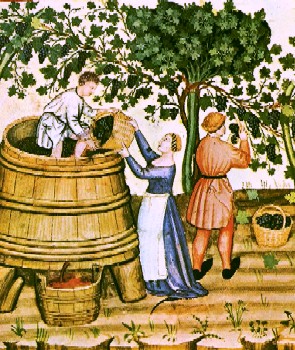
Making Wine, From Tacuinum Sanitatus (14th - 15th c.)
the heavier, more alcoholic wine of Spain and the Mediterranean, which were able to survive the long distances over which they travelled... in their search for wines that would survive the long sea voyages to England, the Netherlands and the Baltic, the merchants of northern Europe increasingly turned to the sweeter, more alcoholic wines of Iberia and the Mediterranean. These fetched higher prices than the wines of France and Germany became more popular in Europe.6
Shippers discovered that "when tossed around in barrels on the high seas, wines rapidly went sour and became unpalatable."7 However, over time shippers learned that wines in larger casks stayed sweet longer than those stored in smaller casks. Historian Tim Unwin points out that although the reason wasn't understood at the time, "larger barrels presented [exposed] a smaller percentage of their contents to the air, and this therefore reduced the rate at which the Acetobacter [acetic acid bacteria] turned the ethanol in the wines to acetic acid."8 Topping the wine in the cask up would further help preserve the wine, although this would have been rarely, if ever, done on a ship.
By the end of the seventeenth century, better, stronger bottles and better-fitting corks made it possible for bottled wine to last longer than casked wines.9 Still, glass was fragile and more difficult to ship than casks, so the majority of wine shipped in casks, often pipe-sized. Unwin notes that "the bottling was undertaken by the merchants or eventual purchasers rather than by the wine producers"10. In twelve accounts of cargos taken by pirates, wine is only mentioned as being bottled three times11 and casked ten times12.
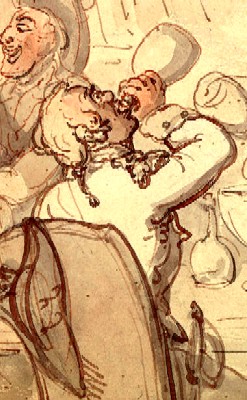
Artist: Thomas Rowlandson
From Naval Officers and a Bowl of Punch (18th c.)
Two of the accounts mentioning bottled wine indicate that it was reserved either for trade or for the officers of the ship while the third is not clear on this point, although it mentions the pirates taking both casks and bottles out of a captured vessel. Bottled wine was available only to officers while aboard Navy ships; the men drank watered down 'beverage wine' which was purchased in casks with water being added before it was doled out. Unwin points out that there was "an important distinction in the types of wine drunk by the different classes: only the rich could afford wines of greater quality from further afield, while the poor consumed the cheaper local wines"13. Although he is referring to people on land, the situation on a naval ship was similar - the men got the cheap, local wines, watered down, while the officers had access to more expensive, possibly bottled wine. Navy chaplain Henry Teonge said in his diary that in 1679, "our new Captain is wondrous free... of his excellent wine" among the officers.14
Another factor affecting which wines made the voyage to England and the English colonies in Central and North America was the political situation. In the seventeenth century, England preferred to import wines from their territories and friendly nations, while making it difficult to import wines from nations with whom they were in opposition. Such politics resulted in "an outburst of vineyard development in the Atlantic islands of Madeira and the Canaries" in the 16th and 17th centuries.15
In the year before the golden age of piracy (defined here as 1690 -1725) the Nine Years War began which pitted the English, Dutch and Spanish (among others) against the French and Jacobites. Not coincidentally, on July 24th, 1689, 'an act for prohibiting all trade with France' was instituted with a three year expiration. In 1691, 'an act against corresponding with His Majesties' enemies' passed which prohibited export and import from France. Some of these restrictions were relaxed two years later to allow import of French brandies. However, in 1697 'an act for granting to his majesty an additional duty upon all French goods and merchandizes' was created.16
In 1701, the War of Spanish Succession began, 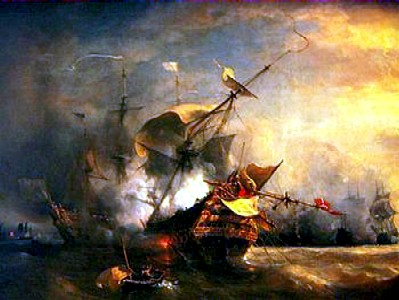
Artist: Jean Antoine Théodore de Gudin
Battle of Cape Lizard in 1707, War of Spanish Succession (19th c.)
lasting thirteen years. This pitted the English, Dutch, Hapsburg Spain and Portuguese (among others) against France and the Spanish monarchy (among others). Here, regulated commerce was allowed with France, with taxation over and above the normal amount on wine taken from French prizes. This was designed to encourage trade with England's ally Portugal, and obtain supplies for the war.
However, three years after the commencement of the war, 'an act for prohibiting all trade and commerce with France' was created, which stopped imports from France, but allowed exports. There was a proviso in the law that allowed import of French wines which had been contracted for before the order passed. (The English elite liked French wines.) There was also a proviso which favored trade with Spain because some parts of Spain were in league with England.17 (Everyone seemed to like Spanish wines.)
Wine grapes were being grown all over the settled world and, if they wanted it for their trip, ships would restock their supply whenever they could get it. As Tim Unwin suggests, the expense to the Spaniards of shipping wines needed for mass to the New World "provided a ready incentive to begin the planting of vineyards and the production of wine in these newly conquered lands."18
A great deal of planting was implemented by the Spanish. During his privateering voyage in the early eighteenth century,
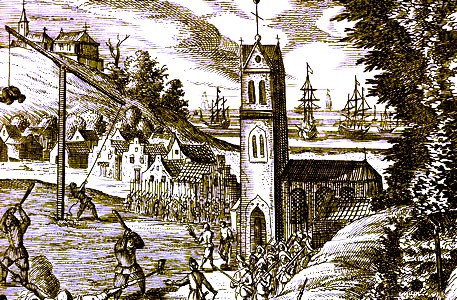
Bucaneers Attacking a Port City in the New World, Buccaneers of America, p. 21 (1678)
Woodes Rogers noted that Chili had a "Store of noble and generous Wines, both white and red; their Vines are larger, and their Clusters of Grapes much bigger than any in Europe."19 He also mentioned that the wine found near the River de La Plata
(near modern Buenos Aires, Argentina) "'tis not to be preserv'd from turning sour without a great mixture of Lime."20 (This is mostly of interest here because there was wine being made in Argentina at this time.) Still, for the most part, South and Central American Spanish wines do not appear to have been very accessible to the English except through raids.
In addition to generic wines, several specific wines are mentioned several times in the accounts of English sailors and pirates. These are quite different from the wines that are popular today, primarily because of English taste preferences, problems with shipping wines and politics. This part of the article will first look at a Persian, French and Spanish wine mentioned only briefly in period sources. This is followed by an examination of some particular wine types including claret, sherry and sack as well as wines which come from Malaga, Spain, Madeira and the Canary Islands. The wine section will finish with a look at both the reasons to drink and to avoid wine as suggested by physicians and surgeons of the time.
1 Samuel Atkins, "A Sailor's Journal", Colburn's United Service Magazine, Part 3, 1854, p. 545, John Baltharpe, The straights voyage, or, St. Davids poem, 1671, p. 14, 15, 52, 53, 54, 61 & 86, Edward Barlow, Barlow’s Journal of his Life at Sea in King’s Ships, East and West Indiamen & Other Merchantman From 1659 to 1703, p. 52, 159-60 &172, Clement Downing, A Compendious History of the Indian Wars, 1737, p. 91 & 99, Henry Teonge, The Diary of Henry Teonge, Chaplain on Board H.M.’s Ships Assistance, Bristol, and Royal Oak, 1675-1679, 1825, p. 189, 216 & 292; 2 Teonge, p. 2, 27, 28, 32, 40, 43, 44, 51, 54, 55, 61, 67, 72, 81, 96, 99, 132, 133, 137, 139, 147, 148, 153, 154, 159, 160, 163, 164, 165, 166, 179, 186, 187, 188, 189, 199, 268, 270, 271, & 300; 3 Barlow, p. 236, 266 & 270, George Roberts, The four years voyages of Capt. George Roberts, 1726, p. 11 & 340-1, Thomas Phillips, 'A Journal of a Voyage Made in the Hannibal', A Collection of Voyages and Travels, Vol. VI, Awnsham Churchill. ed., p. 186, 201 & 202, Francis Rogers. from Bruce S. Ingram's book Three Sea Journals of Stuart Times, 1936, p. 182, Woodes Roger, p. 14, 16, 171, 177, 279 & 343, William Snelgrave, A New Account of Some Parts of Guinea, 1724, p. 28, George Shelvocke, A Voyage Round the World by Way of the Great South Sea, 1726, p. 9; 4 Daniel Defoe (Captain Charles Johnson), A General History of the Pyrates, Manuel Schonhorn, ed., 1999, p. 67, 261, 271, 360, 368, 442, 462, 469, 470, 507, 618, 631 & 639, Ed Fox, “2. William Phillips The Voluntary Confession and Discovery of William Phillips, 8 August, 1696. SP 63/358, ff. 127-132”, Pirates in Their Own Words, 2014, p. 29, Fox, “21. The Whydah survivors tell their stories”, Pirates in Their Own Words, p. 91, Fox, 23. Bartholomew Roberts writes: Bartholomew Roberts to Lt. General Mathew, 27 September 1720.”, Pirates in Their Own Words, p. 109, Fox, “28. The petition of John Massey and George Lowther, from EXT 1/261, ff. 197-199", Pirates in Their Own Words, p. 133, Fox, “30. Alexander Thompson: The Information of Alexander Thompson, 2 March 1722.", Pirates in Their Own Words, p. 141; Fox, “63. Adam Baldridge: Deposition of Adam Baldridge, 5 May, 1699…", Pirates in Their Own Words, p. 347, Fox, “67. Prices of Pirate Supplies: A List of the Prices that Capt. Jacobs sold Licquors and other Goods att, at St. Mary’s, 9 June, 1698…”, Pirates in Their Own Words, p. 362, George Roberts, pp. 41, 47, 48, 49, 59, 60, 60-1, 72, 79, 82, 89, 90, “109. Deposition of Thomas FitzGerald and Alexander Mackonochie. May 6, 1717.”, Privateering and Piracy in the Colonial Period Illustrative Documents, John Franklin Jameson, 1923, p. 252-3, "Pyrates Lately taken by Captain OGLE", 1723, p. 54, William Snelgrave, A New Account of Some Parts of Guinea, 1724, pp. 257 & 258, "The Trial of Eight Persons Indited for Piracy &c", 1718, p. 10 & The Boston News-Letter, Monday August 15 to Monday August 22. 1720. American Weekly Mercury, Vol 1, 1719-1720, The Colonial Society of Pennsylvania, 1898, p. 26, Weekly Journal or British Gazetteer, 8-10-17. Calendar of Virginia State Papers and Other Manuscripts, 1652-1781, William P. Palmer, ed., Vol. 1, 1875, p. 196; 5 Tim Unwin, Wine and the Vine, 2005, p. 201; 6 Unwin, p. 201-2; 7,8 Unwin, p. 221; 9 Unwin, p. 222; 10 Unwin, p. 223; 11 "109. Deposition of Thomas FitzGerald and Alexander Mackonochie. May 6, 1717.”, Privateering and Piracy in the Colonial Period Illustrative Documents, John Franklin Jameson, 1923, p. 253, Daniel (Captain Charles Johnson), pp. 261 & 631, Ed Fox, “67. Prices of Pirate Supplies: A List of the Prices that Capt. Jacobs sold Licquors and other Goods att, at St. Mary’s, 9 June, 1698…”, Pirates in Their Own Words, 2014, p. 362; 12 Fox, “43. Henry Treehill, from The Information of Henry Treehill, 21 March, 1724. HCA 1/55, ff. 64-68”, Pirates in Their Own Words, p. 203, Fox, “2. William Phillips The Voluntary Confession and Discovery of William Phillips, 8 August, 1696. SP 63/358, ff. 127-132”, Pirates in Their Own Words, p. 29, Fox, “28. The petition of John Massey and George Lowther, from EXT 1/261, ff. 197-199", Pirates in Their Own Words, p. 133, Fox, “33. James Williams, from The Examination of James Williams, 27 March, 1725. HCA 1/55 ff. 103-104”, Pirates in Their Own Words, p. 161, Fox, “61. Bridstock Weaver and William Ingram, The Proceedings on the King's Commission of Oyer and Terminer... (London, 1725)", Pirates in Their Own Words, p. 322, Fox, “63. Adam Baldridge: Deposition of Adam Baldridge, 5 May, 1699…", Pirates in Their Own Words, p. 347, “119. Trial of John Fillmore and Edward Cheesman. May 12, 1724”, Privateering and Piracy in the Colonial Period Illustrative Documents, John Franklin Jameson, 1923, p. 277, The Boston News-Letter, Thursday April 30. To Thursday May 7. 1724, William Snelgrave, A New Account of Some Parts of Guinea, 1724, pp. 258, Fox, “67. Prices of Pirate Supplies: A List of the Prices that Capt. Jacobs sold Licquors and other Goods att, at St. Mary’s, 9 June, 1698…”, Pirates in Their Own Words, p. 362, Grey, p. 33, Defoe (Captain Charles Johnson), pp. 308 & 470; 13 Unwin, p. 200-1; 14 Henry Teonge, The Diary of Henry Teonge, Chaplain on Board H.M.’s Ships Assistance, Bristol, and Royal Oak, 1675-1679, 1927, p. 251; 15 Unwin, p. 213-4; 16 Great Britain, Term Reports in the Court of King's Bench, Volume 6, 1827, p. 27; 17 Great Britain, Term Reports..., Vol. 6, p. 28;18 Unwin, p. 191; 19 Woodes Rogers,p. 343; 20 Woodes Rogers, p. 85
Alcohol: Wine - Some European and Mediterranean Wines
A couple of types of wine are only found in a few sources, including some Mediterranean, French and Spanish Wines. Spanish ports were open to the English up until the War of Spanish Succession, which lasted from 1701 through 1713. However, as we have seen, parts of Spain still sided with the English and Spanish wines were still available to them, albeit less so.
The first mention of a non-claret French wine comes from Edward Barlow's journal in 1675. This predates the golden age of piracy as defined here, occurring when Great Britain was allied with France
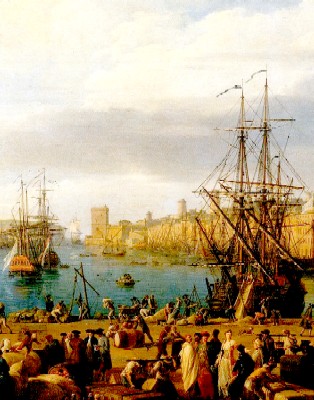
Artist: Claude-Joseph Vernet - Marseille Port (1754)
against the Dutch and Spanish (among others) in the Franco-Dutch war. Barlow was serving on the merchant ship Fflorintine, which had stopped in Marseille. Marseille has been producing Province wines since around 600 BC, being known for its rose wines since the 14th century.1 Upon being granted pratique (permission to go on shore once the ship was given a clean bill of health), Barlow noted "we went about the town to look about us and called for a cup of wine to make ourselves drink, for they have very good wine and cheaper than good beer in England, and the Frenchmen that were passengers made all of us drink very freely."2
A second French wine is mentioned when Edward Lowther's pirates took a French sloop out of which they grabbed "thirty Casks of Brandy, [and] five Hogsheads of Wine"3. While this brief comment doesn't specify the type of wine, it was almost certainly French.
From a health perspective, Physician Tobias Venner notes that French wines (other than claret - "would to God they were so common as Claret") did "far excel other wines ...They notably comfort the stomack, help the concoction and distribution of the meats [food], and offend not the head with vaporous fumes. They are Regall Wines indeed, and very convenient for every season, age, and constitution, so they might be had."4
Another account that just pre-dates the golden age of piracy comes from the poem of Navy clerk
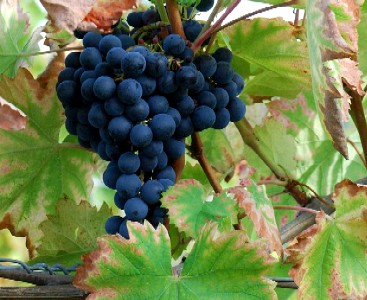
Photo: Wiki User Pancrat - Monastrell/Mourvèdre Grape
John Baltharpe's poem about the voyage of the St. David in 1670. This occurred during a time of peace between the Second and Third Dutch wars. He says,
But on the sixth [of August], got [reached] Alicant:
Where we did get Wine special good,
Called by Englishmen, Ox-blood.
Like Blood it is, for it doth cherish,
Both Heart and Body, and us nourish.5
Chaplain Henry Teonge twice mentions Alicante wines (calling them 'Aligante' wines) while the HMS Assistance was in port there in July of 1675.6
Alicante was well known for its wines in the 16th and 17th centuries, primarily growing grapes varietals white Muscat (called Moscatel in Spain) and red Mourvèdre (called Monastrell in Spain). Alicant Muscat is a sweet wine with high alcohol content. Mourvèdre "Is rich and though it may be comparatively neutral on the palate, it is more usually quite astringent when young, high in acid and alcohol"6. Since Baltharpe called the wine they were drinking 'Ox's blood', we can safely assume that it was the Monastrell.
Nothing is said about Alicante wines in relation to health. However, Spanish wines are used in the make up of Aqua Peoniae Comp which appear in the Sea Surgeon's dispensatory.
Teonge briefly mentions a variety of other European wines in the extensive list of alcohols consumed during his tours with the English Navy. He twice discusses 'Siracoosa' wine, once drinking it7 and another time purchasing it.8 Siracusa is a type of wine from the southeast corner of Sicily near Syracuse. The primary wine made here
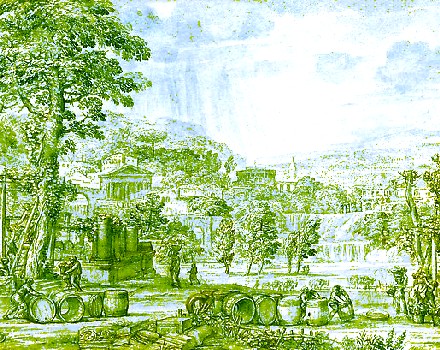
Artist: Pietro_Berrettini - Tuscan Winery in Cortona, Italy, The MET (c. 1630)
during this period would have been from Muscat grapes, which Cyrus Redding referred to in 1851 as " a red muscadine, equal to any other in the world, if not superior."9 Being centrally located in the Mediterranean, "the area's high quality Muscat soon became famous throughout the Mediterranean, from the Levant to southern Spain. The link between the city's trade-friendly accessibility and the success of its wines is clear"10.
Another type of Italian wine discussed twice in passing by Teonge were the 'Florence wines'11. He doesn't provide any comments for or against these wines, nor does he provide any description of it, merely noting that the officers drank it at dinner. Florence is in the Tuscany wine region, which has been producing wine since at least the 8th century BC. It is difficult to pinpoint what type of he was drinking, since they seem to have had a variety of varietals in the 17th century. Although he was writing 125 years after the end of the golden age of piracy, Redding mentions several wine grapes including Mammalo, Canajuo (Canaiolo), Muscat, Barbarossa and Malvasia grapes in conjunction with Florence.12
Teonge mentions one other wine three times, although here he is little more open in giving his opinion of it. In his June 3rd, 1676 diary entry, he explains that the officers spent the evening "drinking healths to our friends in good Cyprus wine."13 Teonge apparently thought enough of it that he went ashore at Cyprus two days later "to buy wine to carry (God willing) into England"14. The officers had it again on June 3rd. Wine production dates back to 2,300 BC and likely back to 3000 BC or more on the Island of Cyprus.
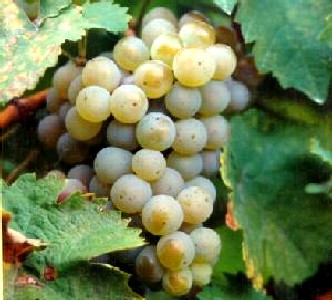
Photo: Wiki User Benalish -
The Müller-Thurgau Grape,
Used to Produce Liebfrauenmilch Wines
A great many wine grape varietals grow there, making it impossible to say exactly what type of wine Teonge was drinking.
There are three other wines mentioned by name, each being talked about only once in the sailor's accounts under study. Sailor Francis Rogers mentions 'Shiras' wine being drunk at Surat, India, explaining that it is "a very strong pale red wine made in Persia"15. Shiraz wine was originally produced in the city of Shiraz (now in Iran), beginning in the 9th century. However, this was a dry, white wine, unlike that mentioned by Rogers, so it is not entirely clear what type he was drinking.
Navy sailor Samuel Atkins talks about two Greek wines made in Zante (Zakynthos Island). The first is of a "sort they call Romboly [probably Robola], sold for 2d. or 3d. a gallon, a strong wine, and mixes extraordinary well with water, being very good for table."16 Robola is a white grape, considered to be one of the best wine varieties in Greece.17 The second is red Muscadine, "a very good wine, but hard to preserve. It's sold for 12d. a gallon. The isle yields not much of it."18
He mentions a third type of wine found only in Cephalonia, which he notes "is much larger than that of Zant, better soyle, and affords more currents."19 The wine found here which Atkins highlights is "Luke-sherry (whence ye best wine of that name (otherwise called White Muscadine), is had)".
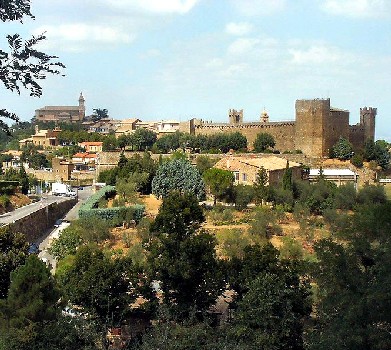
Modern Montalcino, Italy
Greek muscadine is made of Muscat Blanc a Petits Grains grapes, which produces a sweet wine. A variety of wines have been produced from this varietal since at least the 1600s.20
Two Italian wines are mentioned in sailor Samuel Atkins' naval account. While in Bolsena, Italy in 1682, he says that "ye wine at every stage extraordinary good. [These include] Small white wines, called Mountalechina [probably montalcino], Mountepalchina [probably montepulciano], &c."21 Curiously, both of these wines are today said to be made from red, not white, grapes. While Montepulciano can refer to either a grape or a city in Italy, Montalcino only refers to a city where wine is made. So it may be that Atkins had white wines from those regions rather than the red wines associated with them today.
The other single-mention wine comes from our friend Henry Teonge who, in a laundry list of 'answerable' alcohols that the captain of HMS Assistance made available to his officers was a 'Rhenish' wine.1 Rheinhessen is the largest wine-making region in Germany, which has been producing wines since Roman times. They produce a wide variety of wines, historically focusing on white grapes such as Reislings, probably being best known for their Liebfrauenmilch wine.
1 "Provence Rosé History", provincewineusa.com, gathered 11/26/17; 2 Edward Barlow, Barlow’s Journal of his Life at Sea in King’s Ships, East and West Indiamen & Other Merchantman From 1659 to 1703, p. 270; 3 Captain Charles Johnson, A general history of the pirates, 2nd Edition, 1724, p. 353; 4 Tobias Venner, Via Recta ad Vitam Longam, 1638, p. 33-4; 5 John Baltharpe, The straights voyage, or, St. Davids poem, 1671, p. 52; 6 Henry Teonge, The Diary of Henry Teonge, Chaplain on Board H.M.’s Ships Assistance, Bristol, and Royal Oak, 1675-1679, 1825, p. 43 & 44; 7 Teonge, p. 51; 8 Teonge, p. 139; 9 Cyrus Redding, A History and Description of Modern Wines, 1851, p. 281; 10 "Siracusa Wine", wine-searcher.com, gathered 1/8/18; 11 Teonge, p. 55 & 199; 12 Redding, p. 279; 13,14 Teonge, p. 188; 15 "Mourvedre", eliseosilva.com, gathered 11/26/17; 15 Francis Rogers. from Bruce S. Ingram's book Three Sea Journals of Stuart Times, 1936, p. 182; 16 Samuel Atkins, "A Sailor's Journal", Colburn's United Service Magazine, Part 1, 1854, p. 210-1; 17 Konstantinos Lazarakis, The wines of Greece, 2018, p. 51; 18,19 Atkins, p. 211; 20 "Muscat Wines of Greece", www.muscat-wines.com, gathered 11/20/18; 21 Samuel Atkins, "A Sailor's Journal", Colburn's United Service Magazine, Part 3, 1854, p. 545; 22 Teonge, p. 28
Alcohol: Wine - Claret
Claret referred to wines from Bordeaux, France
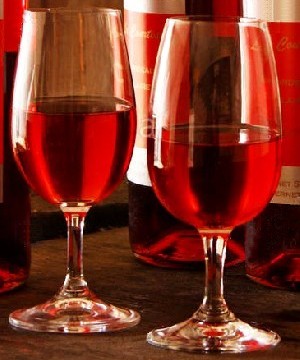
The Deep Rose Color of Clairet Wines
in the eighteenth century. "Before 'claret' was the nickname for deep red Bordeaux wines, it meant 'clear,' 'pale' or 'light-colored' wine ('claret' being derived from the Latin word for 'clear')."1 Writing in 1851, wine writer and journalist Cyrus Redding explained, "Clairet wines in France signify those which are red or rose-coloured. Thus rose-coloured mousseux wine is called clairet, or rosé; there is no such original term as claret in France for wine; it is an English corruption of clairet."2 The claret wines found during the golden age of piracy would have been somewhat dark rosé wines which had only fermented for a few days. "The resulting wine was lighter and fruitier than the red Bordeaux style we know today – lighter, fruitier and less cellarworthy."3
Claret wine is specifically mentioned in four places in the naval accounts4 and in four places in pirate accounts5, although two of them refer to the taking of William Snelgrave's ship by the pirate crews of Thomas Cocklyn, Howell Davis and Olivier Levasseur, meaning there are really only three unique mentions of this wine in the pirate accounts.
All of the mentions of claret in the navy accounts come from Reverend Henry Teonge's voyages aboard Her Majesty's ships Assistance, Bristol, and Royal Oak. Teonge explains that "no sooner arived [in London to begin his naval service], but I was courteously received" by a Lieutenant Haughton and a Captain William Holden, each of whom he said gave him "bottells of claret &c"6. He mentions claret amongst several other types of wines with some admiration for the Captain who offered them during his first voyage aboad the Assistance in 1675.7 His other two mentions of claret are in the fort at Tangiers and at sea.
William Snelgrave's claret appears to have been part of his cargo and mention of it only occurs when one of the pirates took and put on Snelgrave's black suit of clothes. This did not impress the other pirates who, "seeing him dress'd in that manner [wearing fancy clothes], had thrown
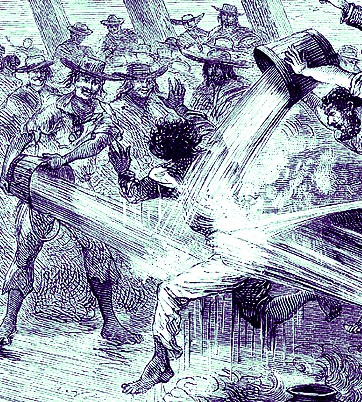
Dumping Buckets of Liquid on a Sailor (19th c.)
several Buckets of Claret upon him."8 The other two accounts simply mention that the crews of Samuel Bellamy9 and George Lowther10 had taken claret wine out of ships they had captured.
Physician Tobias Venner notes that claret is mild and astringent and that "it breedeth good humors [in the body], greatly strengtheneth the stomack, quencheth thirst, stirreth up the appetitie, helpeth the concoction [of food into humors], and exhilarateth the heart"11. He advised young people and those of a 'hot' temperament to use them freely. The warm or 'hot' temperaments include the choleric (those rich in the humor yellow bile) and sanguine (those rich in the humor blood). He specifically warns those of a cold and moist temperament - phlegmatics (those rich in the humor phlegm) - to avoid claret, because it "is of all wines (in regard of the rheumatick nature of it) the most pernicious"12. Still, Venner says clarets are "a pure and quick Wine, scarcely inferiour to any of the regall Wines of France"13.
An unsigned book published in 1726, named after Thomas Tryon's The Way to Health and Long Life, repeats Venner's simplest observations on the benefits of claret, but warns "take notice that this, as all other strong Liquors, are not to be frequently used, for then they became prejudicial, but a Glass of Wine, or a Dram of Brandy, when you have eat too much in quantity, are good Cordials, and Digesters."14 Parts of this echo things Tryon said in the original book, although he was no fan of alcohol and would likely never have recommended them.15
1 “Ask Dr. Vinny”, winespectator.com, gathered 11/26/17; 2 Cyrus Redding, A History and Description of Modern Wines, 1851, p. 80; 2"Bordeaux Clairet Wine", wine-searcher.com, gathered 11/28/17; 4 Henry Teonge, The Diary of Henry Teonge, Chaplain on Board H.M.'s Ships Assistance, Bristol, and Royal Oak, 1675-1679, 1825, pp. 2, 28, 32 & 44; 5 William Snelgrave, A New Account of Some Parts of Guinea, 1724, pp. 258, Ed Fox, “21. The Whydah survivors tell their stories”, Pirates in Their Own Words, 2014, p. 91, Ed Fox, “30. Alexander Thompson: The Information of Alexander Thompson, 2 March 1722.", Pirates in Their Own Words, 2014, p. 142 & Charles Grey, Pirates of the Eastern Seas (1618-1723), 1933, p. 120; 6 Teonge, p. 4; 7 Teonge, p. 28; 8 Snelgrave, p. 258; 9 Fox, p. 91; 10 Fox, p. 142; 11,12 Tobias Venner, Via Recta ad Vitam Longam, 1638, p. 29; 13 Venner, p. 29-30; 14 The Way to Health and Long Life, 1726, p. 38; 15 See Thomas Tryon, The Way to Health and Long Life, 1697
Alcohol: Wine - Sacks: Sherry
Sherry got its name from the city that created it: Jerez, Spain. Writing in 1851, Cyrus Redding explained that sherry

Wine Growing Triangle (Green) for Sherry, From a Map By R. M. Martin (1851)
is made in Andalusia, near Cadiz, on the west coast, between the rivers Guadalquiver and Guadalete. The district included in the province of Cadiz is of a triangular form, having on the northern angle the town of St. Lucar de Barrameda; on the southern angle, the Puerto de Santa Maria; and the eastern point formed by the town of Xeres de la Frontera [Jerez], from which the wine takes its name, the English having first changed Xeres into Sherris, and finally into Sherry.1
When the Spanish began sailing to the new world in the 16th century, they took wine with them, much of it coming from the region around Jerez.2
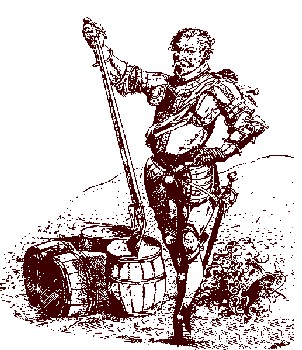
"Sir Francis Drake The Noblest Knight"
Sir Francis Drake took 2900 casks of sack (presumably sherry) that were waiting to be loaded on ships when he captured Cadiz in 1587.3 "Many historians claim that Drake's love for sherry and his famous sacking helped introduce sherry drinking to a far wider audience and no doubt contributed to the English enthusiasm that almost single-handedly made sherry one of the world's most revered wines."4
Today, sherry is made from three grape varieties: Palomino, Pedro Ximénez and Moscatel. All are white grapes, the first being used to make dry sherry and the second two being used to make sweet sherry. However, during the golden age of piracy, there may have been as many as 100 different grape varieties being grown to make sherry.5
Sherry is generally believed to have been fortified with brandy during this period, although it is difficult to pinpoint when this began. Wine expert Julian Jeffs says, Elizabethan sack wines "were certainly fortified... but they were seldom matured in the wood for more than a year or two."6 It is often suggested that wines began to be fortified to keep them from souring during shipping. However, historian Tim Unwin explains that "even without this fortification their strength ensured a higher degree of stability than that of most other wines."7
Jeffs notes that these would have been sweet wines, which makes sense given the English proclivity for sweet, alcoholic wines at this time. Commenting 120 years after the end of the golden age of piracy, Redding said, "In Spain, from the slovenly fermentation, and mixture of bad grapes with good, ropiness [being composed of sticky, glutinous threads] is very common. It is cured by mixing brandy with the wine, principally sherry, which also makes it more agreeable to the English palate."8 Henry Jeffreys notes that sherries during this period "would have been consumed as young as possible but, as with Madeira, a sherry from a good vintage and properly kept could last. It even improved on tropical voyages."9
Sherry is specifically mentioned by three authors in five places.
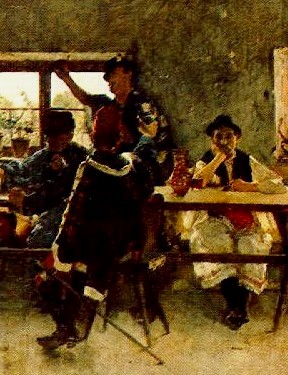
Artist: Simon Hollosy - Carousing in the Tavern (1888)
While aboard the 4th rate naval ship Yarmouth, Edward Barlow mentioned in his journal that they anchored off of Cadiz in 1669, where "our purser paid us here the rest of our short allowance money, which we made merry with in good sherry wine, drinking healths to our friends in England, hoping ere long to arrive safe there."10 (Short allowance money was paid to navy sailors for every three months they were in a foreign port.) Six years later, when the merchant ship fflorentine was in port, Barlow noted that the residents of Greenock, Scotland drank "mostly sherry instead of ‘sack’ or ‘canarey’ [Canary]", although he didn't comment on its quality.11
Writing to the girlfriends of navy sailors of the St. David about their return home, clerk John Baltharpe says
And we'l bring home some Spanish Sherry,
On purpose for to make you Merry.
Long time 'twas since our last Adue,
Yet oft-times have we thought on you;
And many a cheerful Spanish Cup,
In your remembrance we have Supt:
Indeed the same did you no good,
But yet it cheer'd, and warm'd our Blood12
Chaplain Henry Teonge also mentions sherry as part of a list of alcohols that the captain of the
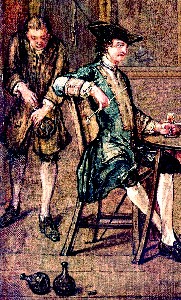
Artist: Marcellus Laroon the Younger
Interieur mit Figuren (c. 1750)
HM Assistance offered to the officers of his ship, which Teonge noted "were answerable" in admiration of the variety on display.13
Teonge also says that a toast was offered to King Charles II "in good luke-sherry" later during the same voyage.14
Sherry had some advocates among the medically-minded. "Sherry is a fine Cordial Wine, being mixt with Water it begets and Appetite."15 Cordials were alcoholic beverages given by doctors to calm patients and to help them heal. Improving appetite would be an example of this - appetite refers to food going into the body and being converted into bodily humors. If it were the right kind of food, the humors would be beneficial and the body would heal faster. Sea surgeon John Atkins advises its use in the diet of men recovering from a fracture, suggesting that the patient be giving "a common Drink, Sack-Whey [sherry with whey (weak milk) and sugar]"16.
Physician James Rennie has another, simpler reason for giving it. When treating a flux (diarrhea) he says that hartshorn is a good remedy, being "emollient (soothing) and nutritive, but requires to have orange juice and sherry wine added, to cover its gluey flavour."17 So the sweet, strong sherry was simply being used to disguise the taste of the hartshorn. However, by and large, the doctors of this era seem to seldom have use for sherry.
1 Cyrus Redding, A History and Description of Modern Wines, 1851, p. 203; 2 Tim Unwin, Wine and the Vine, 2005, p. 188 & 222; 3 Ned Halley, The Wordsworth Dictionary of Drink, 2005, p. 43; 4 Talia Baiocchi, Sherry: A Modern Guide to the Wine World's Best Kept Secret, 2014, p. 73; 5 Tom Stevenson, The New Sothebys Wine Encyclopedia, 2006, p. 322; 6 Julian Jeffs, Sherry, 2016, not paginated; 7 Tim Unwin, Wine and the Vine, 2005, p. 222; 8 Cyrus Redding, A History and Description of Modern Wines, 1851, p. 72; 9 Henry Jeffreys, Empire of Booze, 2016, p. 103; 10 Edward Barlow, Barlow’s Journal of his Life at Sea in King’s Ships, East and West Indiamen & Other Merchantman From 1659 to 1703, p. 173; 11 Barlow, p. 266; 12 John Baltharpe, The straights voyage, or, St. Davids poem, 1671, p. 86; 13 Henry Teonge, The Diary of Henry Teonge, Chaplain on Board H.M.'s Ships Assistance, Bristol, and Royal Oak, 1675-1679, 1825, p. 28; 14 Teonge, p. 96; 15 The Way to Health and Long Life, 1726, p. 38; 16 John Atkins, The Navy Surgeon, p. 46; 17 James Rennie, A New Supplement to the Pharmacopœpias of London, Edinburgh, Dublin and Paris, Baldwin and Cradock, p. 97

